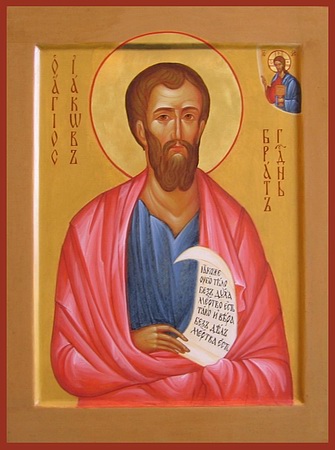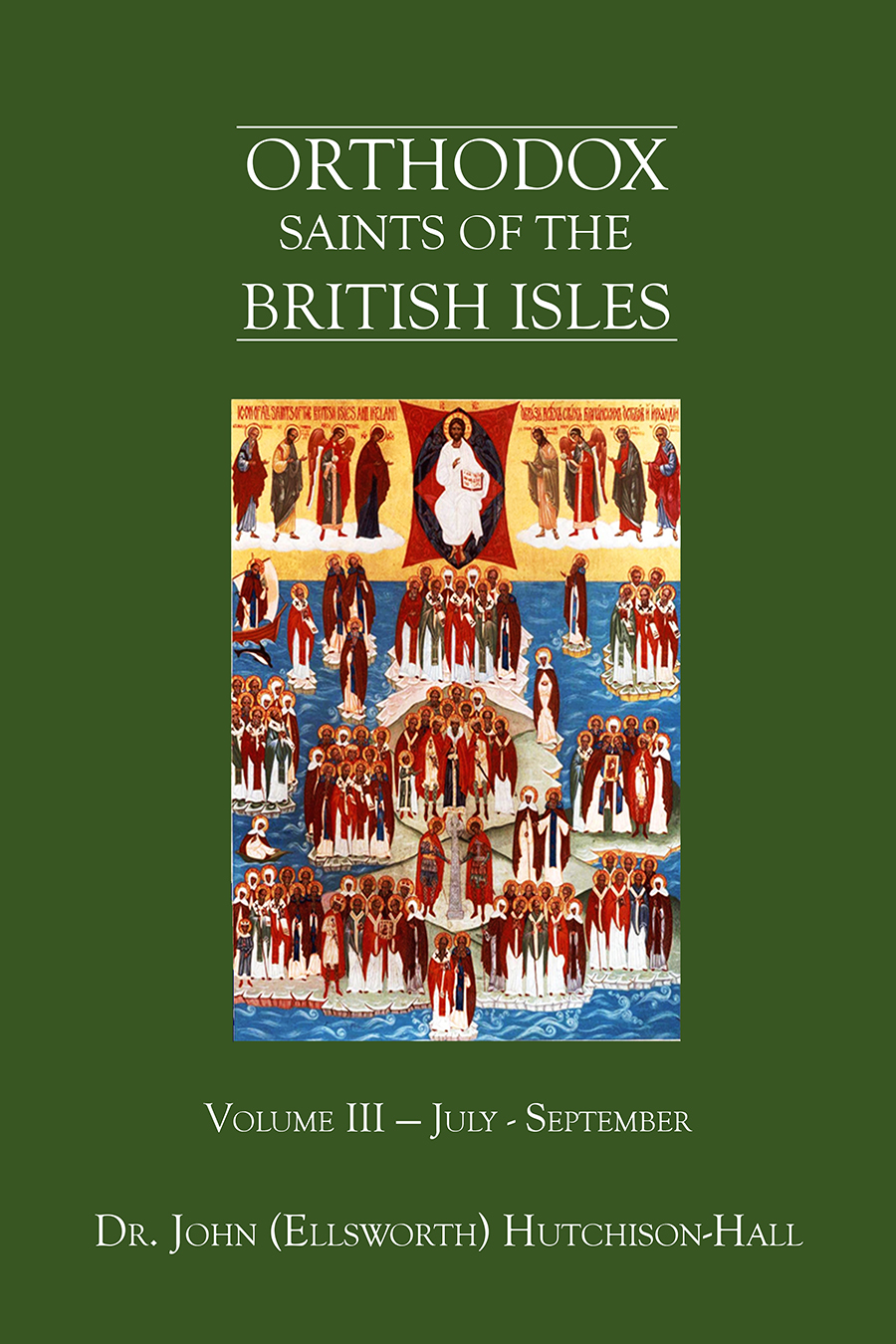
Orthodox Saints of the Pre-Schism
See of Rome
7th August (NS) — 25th July (OS) 2023
APOSTLE JAMES, (on Eastern calendars 30th April and 30th June as one of the Twelve.) The Holy, Glorious, All-Laudable Apostle James, also known as James the Great(er) to distinguish him from the Apostle James Brother of Our Lord, or the Lesser (23rd October). The son of Zebedee, the brother of the Apostle and Evangelist John the Theologian (8th May), the Apostle is counted amongst the Twelve, and is the only apostle whose martyrdom, in 44, is recorded in the New Testament (Acts 12:1-2), and therefore is traditionally said to be the first of the twelve apostles martyred for his faith. According to legend St. James travelled as far as Spain, where he is the patron saint, and his relics are said to be enshrined Santiago de Compostela in Galicia. The Camino de Santiago has been a significant pilgrimage route since the Early Middle Ages. The Apostle James is also commemorated on 30th December in the Mozarabic Rite.
Troparion of The Holy, Glorious, All-Laudable Apostle James
Tone VIII
As a soldier of the Lord you were ranked among the choir of apostles
Together with your brother, O James, you clung wholeheartedly to the Saviour.
Armed with the power of the Spirit you preached him to all and were slain by the sword.
Therefore we sing your praises!
Troparion of The Holy, Glorious, All-Laudable Apostle James
Tone III
You were a chosen apostle of Christ
And the only brother of the beloved Theologian.
Most praised James, ask remission of sins and great mercy
For those who sing hymns to you.
Kontakion of The Holy, Glorious, All-Laudable Apostle James
Tone II
You heard the voice of God calling you
And turned away from the love of your father.
With your brother you hastened after Christ, O glorious James.
With him, you were counted worthy to behold the Lord's divine Transfiguration!
CUCUPHAS (CUCUFATE, CUGAT, GUINEFORT, QOQOFAS) del VALLES, a North African who was martyred circa 304 near Barcelona (north-eastern Spain). St. Cucuphas' relics were translated in 777 to France, and in 835 were enshrined at the Abbey of St. Denis (abbaye Saint-Denis) near Paris. The Monastery of St. Cugat de Valles, north of Barcelona is believed to be situated on the site of his martyrdom.
FLORENTIUS (FLORENCE) and FELIX of FURCONA, two soldiers who were martyred in 235 at the begining of the reign of Emperor Maximinus I (r. 235–238) at Furcona near Aquila (southern Italy) 235.
GLODESIND of METZ, betrothed to a nobleman who was arrested on their wedding day, and soon after executed. An aunt of St. Glodesind, a monastic at Trier in the present-day German state of Rhineland-Palatinate, advised her to enter monastic life. St. Glodesind then received monastic tonsure. She later founded a monastery at Metz (north-eastern France) where she served as the first Abbess. St. Glodesind reposed circa 608.
MAGNERICUS of TRIER, the Bishop of Trier in the present-day German state of Rhineland-Palatinate from circa 566 until his repose in 596. A close friend of St. Gregory of Tours (17th November), St. Magnericus was one of the most well-known and highly respected bishops of his era.
NISSEN of WEXFORD, (Fifth Century), converted by St. Patrick of Ireland (17th March) who then made him Abbot of Montgarth, in present-day Co. Wexford, Ireland.
THEODEMIR of CÓRDOBA, a monk martyred in 851 at Córdoba (southern Spain) for refusing to renounce Christianity, during the reign of Emir Abd ar-Rahman II (r. 822–852). St. Theodemir is buried in the choir of the church of Saint Zoilo in Córdoba.
Get your copy of Orthodox Saints of the British Isles today.
Available at Amazon or your favourite e-bookstore.
CARPOPHORUS, EXANTHUS, CASSIUS, SEVERINUS, SECUNDUS, and LICINIUS, Martyrs of Como, six soldiers martyred circa 295 in Como in the north of Italy during the reign of Emperor Maximian (r. 286–305). According to one legend SS. Carpophorus and Exanthus, were members of the legendary Theban Legion.
DONAT (DUNWYD), (Date Unknown), according to the Menology of England and Wales St. Donat is the patron saint of St. Donat’s, or Llandunwyn, in the Vale of Glamorgan in Wales. There is no further information on his life extant.
DONATIAN of CHÂLONS-SUR-MARNE, (Date Uncertain), a disciple of, and successor to St. Memmius of Châlons-sur-Marne (5th August), and second Bishop of Châlons-sur-Marne (present-day Châlons-en-Champagne north-eastern France).
DONATUS and HILARY (HILARINUS) of AREZZO, (Fourth Century), St. Donatus, the second Bishop of Arezzo in Tuscany (central Italy), and St. Hilary, a monk, were martyred during the reign of Julian the Apostate (r. 361–363). St. Gregory the Dialogist (3rd September) and others have attributed numerous miracles to these saints.
DONATUS, a Frankish aristocrat, baptised by St. Columbanus (23rd November). He received monastic tonsure at the Abbey of SS. Peter and Paul of Luxeuil (abbaye Saint-Pierre et Saint-Paul de Luxeuil), and in time consecrated Bishop of Besançon (eastern France). A great supporter of monasticism, St. Donatus founded the Abbey of St. Paul of Besançon (abbaye Saint-Paul de Besançon). He is also known for the Regula Donati, a monastic rule he wrote for the community founded by his mother after she was widowed. St. Donatus reposed circa 660.
FAUSTUS of MILAN, though there are no particulars of his life extant, tradition has it that he was a soldier who was tortured and eventually killed for the Faith in Milan (north-west Italy) during the reign of Emperor Commodus (r. 180–192).
PETER, JULIAN, and COMPANIONS, though listed in all of the ancient martyrologies, no details of their lives are extant. SS. Peter, Julian, and Companions are said to have been a group of at least twenty martyred in Rome circa 260 during the persecutions by Emperor Valerian and his son and co-Emperor Gallienus (r. 253–268).
VICTRICIUS (VICTRICE) of ROUEN, the son of a Roman legionnaire who followed his father into military service. However, after becoming a Christian, St. Victricius found military service incompatible with his Faith, and refused to continue his military service. He was flogged and sentenced to be executed, however the sentence was commuted, to discharge from the military. St. Victricius became a missionary evangelising the people of Flanders, Hainault, and Brabant (north-eastern France / south-western Belgium). He was consecrated the eighth Bishop of Rouen (Normandy, northern France) circa 386 or 393. He was, at one point, accused of heresy, and was defended from that charge by Pope Innocent I (r. 401–417). St. Victricius was also a respected author and his works include De Laude Sanctorum, based upon a sermon he gave in 396 to welcome a gift of relics from St. Ambrose of Milan (7th December) which is an invaluable source of information on various aspects of religious practices of his day. St. Victricius reposed in 417.
Prior to the Schism the Patriarchate of Rome was Orthodox, and fully in communion with the Orthodox Church. As Saint John of Shanghai and San Francisco +1966 said “The West was Orthodox for a thousand years, and her venerable Liturgy is far older than any of her heresies”.
Details of British Saints excerpted from Orthodox Saints of the British Isles.
Details of continental saints from these sources.
In many cases there are several spelling versions of the names of saints from the British Isles. I use the Oxford Dictionary of National Biography version as the primary version with the more prevalent version in parenthesis e.g. Ceadda (Chad) of Lichfield.


